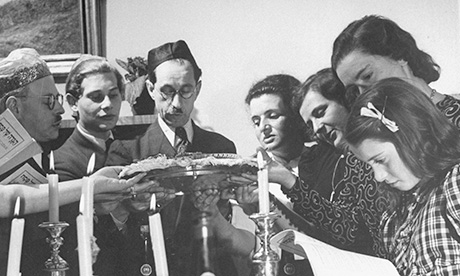To be raised among the ancient biblical myths was to live in a world that melded the material, spiritual, and imaginative. Rich with poetic metaphor, these stories have stimulated the imaginations and moral consciousness of the Jewish people for thousands of years.
In traditional Jewish culture, myth once served many functions. The rituals commemorating the myths provided the Jewish community with a powerful cohesiveness that persisted throughout the community’s dispersal across continents. At the personal level, myths helped individuals to encounter, explain, and gain meaning from their experiences in the world. For children, myths functioned as a nurturing source for spiritual feeling.
The story of Passover is a particularly important myth for Jews. Lovingly sustained by the Jewish community for millennia, it carries sacred and enduring wisdom that is passed down each year from the elders of the family to the children.
Its accompanying ritual, the Passover seder, is one of the oldest surviving rituals in the Western world, dating back some 3,300 years. It is also the most widely observed ritual in Judaism. The lively, family-oriented evening revolves around the retelling of one of Judaism’s most important mythical moments — the Jewish exodus from Egypt. Accompanied with song and good cheer, the seder evening contains both set and spontaneous elements, with riddles, games, and a series of symbolic culinary elements designed to transport the individual back to ancient times, so that they may momentarily suspend reality and experience life exiled in Egypt.
Myths reflect the essence of a group’s religious feeling and core identity — and for Jews, the central mythical motif is that of exile.
In the major biblical stories, exile is referenced through the metaphor of separation from a physical land — exile from the Garden of Eden, exile in Babylon, and exile in Egypt. The metaphor of the faithful wife exiled from her husband is another common expression of exile found in Jewish texts, including poems, prayers, and hymns.
To give but a few examples, In Song of Songs, a beloved young bride is consumed in search for her husband with whom she has been physically separated: “I sought him, but I could not find him; I called him, but he gave me no answer”. Bound together in a mutually devoted relationship, yet physically apart, their love is dominated by a sense of yearning, “O daughters of Jerusalem, I adjure you; if you find my beloved; tell him I am sick with love”. In a poem by Yehuda Halevi titled “The day the depths were turned to dry land”, he writes: “Then return, marry her [Israel] a second time; Do not continue to divorce her; Cause the light of her sun to rise, that the; Shadows shall flee away”. In dark times, when tragedy had befallen the Jews, we find the analogy of marriage reimagined in terms of widowhood, as in this poem by the medieval Rabbi Isaac ben Judah ibn Ghiyyat: “I am bound and troubled as one living in widowhood; I yearn intensely, O Lord, for the Day of Comfort”. Continue reading
Additional readingNews category: Analysis and Comment, Palmerston.




